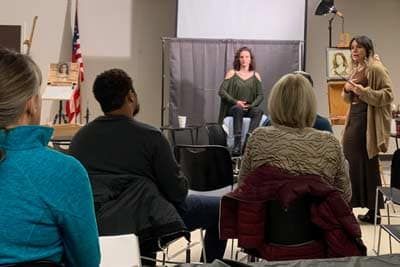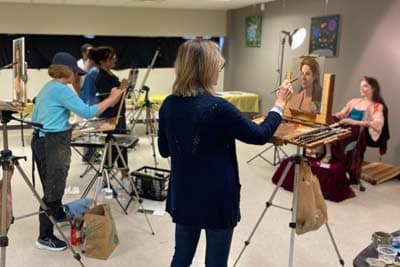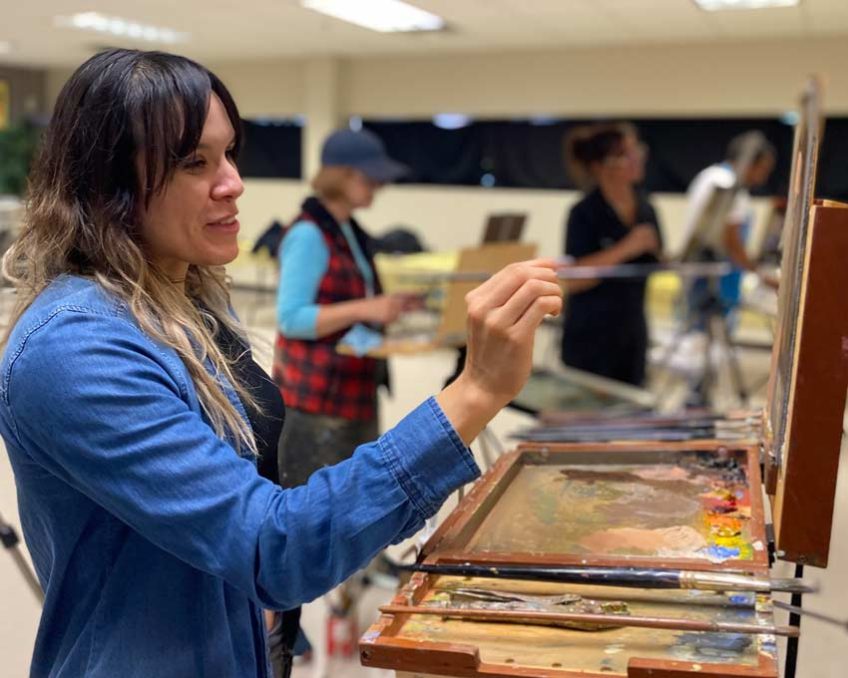by Melissa Crawford

Sandra Sanchez was born an artist, as many of us are. And through community she found a way to live her childhood dreams. Always drawn to art, museums, and beautiful books about painters, she spent four years developing her portraiture skills, along with other genres, at the acclaimed Grand Central Atelier in New York City. Fundamental skills studies began with Bargue plates, understanding the figure and head in terms of planes and shapes. Vanderpoel’s book, The Human Figure was copied many times. Students then moved on to value paintings in just black and white, and finally into color. She studied painting in a variety of media to create a broad range of understanding. Along with developing important technical skills in her four years there, she was learning all the while about the importance of community in her artistic journey.
Fast forward to today, still under 30 years of age, the artist is full of exuberant joy talking about her work and her students. She says teaching helps her make other people’s dreams come true. She loves giving back to the communities that have given so much to her. And it’s a full circle of her teaching, and then learning from those she teaches. When asked what makes a great teacher, Sandra says communication is key. With empathy, she understands the vulnerability of her students, opening her mind and heart to meet their needs. Teaching for her is a collaborative creative experience. Some students have different approaches, and she doesn’t dictate “one way only,” but feels into their way. So one must also ask, “What makes a great student?” And to this, Sanchez opens a door to understanding how she has grown, seemingly so quickly, as an artist and teacher.
Sanchez has the courage to ask. As a student, she learned to be very open to feedback, to ask what her teacher thought, then to ask students and friends. She listened to multiple perspectives. This led her to reach out to other artists in her local community, and then even farther, to online communities. She studied what she loved in others’ artwork and, wanting to understand their approach, wasn’t afraid to ask questions. This opened the door to more art communities, and the momentum grew. Along with all the information she was receiving she spent many hours developing her paintings.
“It is people that have had the biggest compound effect on my art.” It is the people in her classes, and in the community of friends she has built. She’s involved in group chats of artists that offer critiques, share opportunities, and encourage each other to continue the dream. She paints alongside other artists and whether in plein air, in personal studios, or in workshops, she believes that sharing this life with others creates an aliveness in her personal work.

But it wasn’t always this way. The transition from school to making a living as an artist was one of her biggest hurdles. She felt isolated and alone in her struggle, until she forced herself to reach out and be vulnerable to other artists, sharing her fears and hardships. And bit by bit, these baby steps of sharing allowed her to see how everyone struggles. The newfound community encouragement created new worlds of possibility.
Sandra’s journey involves learning from those around her, even down to the art of daily rituals in her studio. She has intentionally slowed down. To begin the day, she enjoys coffee while anticipating a beautiful day ahead. Putting the paint on the palette is an experience of gratitude, the acknowledgment of a new beginning. She has learned to remove work distractions like her phone, and constant snacking. And she takes intentional breaks, like an afternoon tea. She tunes into what makes her creative and what feels good, which creates more balance and play in her art. To break out of ruts she breaks the routine, painting something that she wouldn’t normally paint. Mix things up—paint landscapes, plein air, small studies, or abstracts—and just allow yourself to enjoy the journey is another piece of advice she gives. You can do this by yourself or with community. A book Sandra read, and comes back to is, The Mountain is You by Brianna Wiest. It has given her insight and gentle tools in becoming who she wants to be. Having had the courage to ask, and building on the power of community she continues to break new ground as an artist and teacher.
Sandra Sanchez’s work continues to garner much attention and many awards. Currently, she has work in galleries such as Eleventh Street Arts and the Salmagundi Club in New York City. Along with many other awards, she won the Salmagundi Club Carole Teller Award, and Hudson River Fellowship two years in a row. She currently lives in Anaheim,CA, and teaches in California, New York, and across the country, as well as online courses via the Grand Central Atelier.
Author’s note:
While on a long drive recently, I was reflecting on a project my son Astin was involved in. He had to interview 100 people, of various ages, about where they find happiness, purpose, and joy. Pulling into my driveway, I thought to myself, “I’m going to reach out and interview different artists about how they work and what makes them happy.” Still in the car, and lost in thought, I received a phone call from Luanna Luconi Winner who asked if I would like to interview Sandra Sanchez for this article. It was that immediate… I asked and it was answered. The courage to ask, the power of community.
– Melissa Crawford


